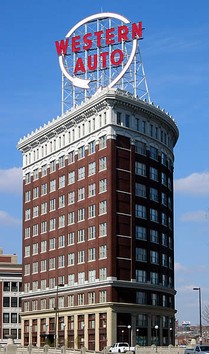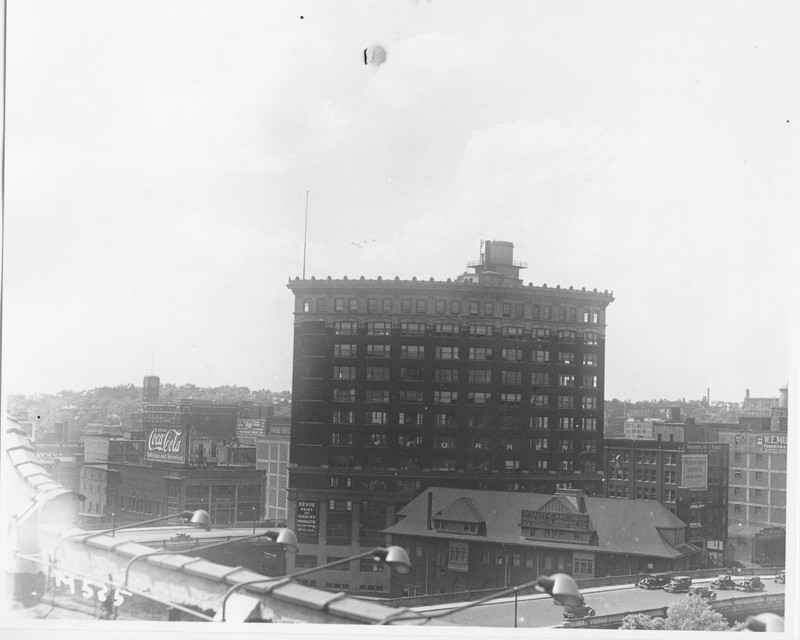Western Auto Building
Introduction
Text-to-speech Audio
One of the iconic symbols of Kansas City, this building was completed in 1915 and designed to fit the pie-shaped piece of land that Coca-Cola acquired in 1913. Company executives Asa G. and Charles H. Candler selected Kansas City as an ideal location for a regional headquarters that year as they expanded operations from Atlanta to the Midwest. The building changed hands several times before Western Auto Supply Company acquired the structure in 1951. The downtown landmark has been known as the "Western Auto Building" since 1952, when the rooftop sign was added. Subsequent owners recognized the sign's importance to Kansas Citians, and it remained in place long after Advance Auto Parts acquired the company and sold the building. Now a residential building called the Western Auto Lofts, the 12-story building was designed to be “fireproof” by utilizing brick and steel, minimizing the use of combustible materials, and adding a sprinkler system. In 2018, the condo owner's association funded repairs and new lights to the rooftop sign.
Images
The Western Auto Building was constructed in 1914. Today it is a residential building.

The Coca-Cola sign is viewable in this circa-1920 photo looking northwest along McGee Street from near 23rd Street.
.jpg)
The building in 1930, two years after the Coca-Cola sign was removed

Postcard of the Coca-Cola Building from KCPL
.jpg)
Backstory and Context
Text-to-speech Audio
Coca Cola dates back to 1891 when Atlanta businessman Asa G. Candler purchased ownership of the recipe for Coca-Cola and the beverage's business operations. In 1913 Coca-Cola acquired an unused parcel at 21st and Grand in 1913 and hired the Swenson Construction Company to execute their design for a triangular building that would fit the space. Although the building is best known for its Western Auto sign, the structure was originally adorned with a large Coca-Cola sign. The Candlers sold their soda company in 1919, and in 1922 that business sold this building as they had already moved most of their Kansas City operations elsewhere. The Coca-Cola company continued to use part of this building until 1932, and the Coca-Cola sign remained until 1928. When the building went into receivership in 1929, the Candler family decided to purchase the distressed but still serviceable property. In 1932, the building became known as the Candler Building and remained in the family’s estate until 1947 when the family donated the building to support Atlanta's Emory University. Three years later, the university sold the building. By 1951, one of its tenants, the Western Auto Company, purchased the entire building. The iconic “Western Auto” sign was placed on top of the building the following year.
Western Auto Company was established in Kansas City in 1909 by Don Davis and George Pepperdine, who used his fortune to establish Pepperdine University in Los Angeles in 1937. Pepperdine and Davis saw an opportunity in supplying aftermarket parts for automobiles. The company began as a mail-order provider, shipping parts for Model T Fords and other early automobiles throughout the Midwest. The company opened its first retail store at 1426 Grand Avenue (just across from the T-Mobile Center of the modern era). The company expanded quickly, becoming a retailer and service provider with 1200 stores at their peak. In 1928, Western Auto began leasing space on this building's 11th floor. After years of expanding their use of rented space, Western Auto purchased the entire building in 1951 and the now-iconic sign followed a year later. The company was acquired by consumer finance firm Beneficial Corporation in 1961 and Sears in the 1980s but continued to operate under the Western Auto name until 1998, when rival retailer Advance Auto Parts purchased the company. The building had been placed on the National Register of Historic Places in 1988, meaning that the new owner would lose potential tax incentives for restoration should they make major changes to the building's historic integrity. As a result, there was a strong disincentive to expend the funds to remove the massive 70 by 73-foot sign, especially given the fondness many Kansas Citians felt for both the sign and the former Kansas-City-based auto parts company and the fact that most of the building was unoccupied after 2000.
The Virginia-based retailer Advance Auto Parts sold this building to a company that intended to convert the structure into luxury condominiums. Thanks to the National Register designation and the affection many Kansas Citians feel for preserving both the iconic building and signature sign, the Western Auto sign once again lights up the city skyline after the condo owners association funded repairs to the sign in 2018.
Sources
Ann McFerrin, "Coca-Cola Building," Missouri Valley Special Collections, Kansas City Public Library, https://kchistory.org/islandora/object/kchistory%3A115127?solr_nav%5Bid%5D=82fc342a811565cad8fe&solr_nav%5Bpage%5D=0&solr_nav%5Boffset%5D=3&search=Western%2520Auto
Western Auto Building, National Register of Historic Places Nomination Form, National Park Service. March 13, 2009
Alonzo, Austin. "My Favorite Building: Western Auto Building." Kansas City Business Journal. October 3, 2013. http://www.bizjournals.com/kansascity/blog/2013/10/western-auto-building.html.
Kansas City Public Library, General Collection (P1), Streets--McGee, Number 9
The Story of The Western Auto Sign, KC Yesterday. Accessed September 1st, 2024. https://kcyesterday.com/articles/western-auto-sign.
https://kchistory.org/image/mcgee-street-4?solr_nav%5Bid%5D=5d0b03f45e1b385ef360&solr_nav%5Bpage%5D=0&solr_nav%5Boffset%5D=5
https://kchistory.org/islandora/object/kchistory%3A103252/datastream/OBJ/view
